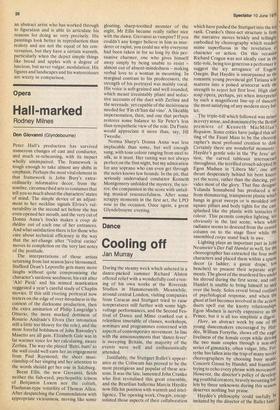Dance
Cooling off
Jan Murray
During the steamy week which ushered in a dance-packed summer Richard Alston offered relief with a wonderfully cool evening of his own works at the Riverside Studios in Hammersmith. Meanwhile, around central London, visiting companies from Caracas and Stuttgart tried to raise temperatures still further with some highvoltage performances, and the Second Festival of Dance and Mime cranked out a relentless timetable of classes, workshops, seminars and programmes concerned with aspects of contemporary movement. In line with the announcements that 'dance fever' is sweeping Britain, the majority of the events were well and enthusiastically attended.
Justifiably, the Stuttgart Ballet's appearance at the Coliseum has proved to be the most prestigious and popular of these seasons. It was the late, lamented John Cranko who first revitalised this great ensemble, and the Brazilian ballerina Marcia Haydee now fills his position with warmth and intelligence. The opening work, Onegin, encapsulated those aspects of their collaboration which have pushed the Stuttgart into the toP 1 rank. Cranko's three-act structure is firm, ' the narrative moves briskly and tellinglY, embodied by choreography which renders,
mime superfluous in the revelation oi character or action. On this occasiolt Richard Cragun was not ideally cast in the title-role, being too generous a performer to suggest the icy arrogance of Eugene Onegin. But, Haydee is unsurpassed as the romantic young provincial girl Tatiana who matures into a poised aristocrat with the strength to reject her first love. High class
soap opera, perhaps, yet when interpreted by such a magnificent line-up of dancers, the most satisfying of any modern story NI' let.
The triple-bill which followed was mixed in every sense, and dominated by the British premiere of Kenneth MacMillan's
Requiem. Some critics have judged this set' ting of the Faure Mass to be the chorea rapher's most profound creation to date.
Certainly there are wonderful moments ' Haydee's gentle solo in the 'Pie Jesu' see: tion, the carved tableaux intersperse° throughout, the terrified crouch adopted 11 Egon Madsen in 'Libera Me', one art° thrust desperately behind his bent knees; yet the score, rather than the dancing, pro'
vides most of the glory. That fine designer Yolanda Sonnabend has produced a sel from shimmering, transparent plastic which hangs in great sweeps or is moulded into square pillars and body tights for the cast; splashed like the plastic with tentacles 01 colour. This permits complex lighting, to° obviously in the last scene, when white radiance seems to descend from the central column on to the stage floor while the assembled corps stand back in awe.
Lighting plays an important part in Jolla Neumeier's Der Fall Hamlet as well, for the choreographer has extracted the four mat° characters and placed them within a sparse decor (a ladder, a gauze drape, low benches) to present their separate arglr ments. The ghost of the murdered lies under his shroud during the first scene, and onlY Hamlet is unable to bring himself to steP over the body. Solos reveal broad outlines of psychological response, and when the ghost atlast becomes involved in the action. duets spell out the knotty relationships. Egon Madsen is nervily expressive as the Prince, but it is all too simplistic a digest. Flore, an abstract work by one of the young dancemakers encouraged by HaY' dee, William Forsythe, shows off the eager liveliness of the female corps while driving the two main couples through a non-stoP series of gimmicky, often vulgar, lifts. For sythe has fallen into the trap of many novice choreographers by choosing busy must°, Concerti Grossi by Handel, and franticallY trying to echo every phrase with movement' However, the director's policy of develor ing youthful creators, bravely mounting b°1" lets by three unknowns during this season. deserves nothing but praise. Hayclee's philosophy could usefully be imitated by the director of the Ballet Inter' neeional de Caracas, Vicente Nebrada, for „the repertory which made up his company's uritish debut at Sadler's Wells lurched from banality to mere efficiency, not much enhanced by a Bejartian obsession with the Pelvic region. The dancers are so vital and Wi ell-trained that they deserve more chalLenging material. Even prima ballerina 4handra Rodriguez, tiny, curvaceous and eroP-haired, had scant opportunity to dis abilities other than the passive ones of uc, mg tied in crotchy knots by her partner. Look-alike divertissements and awkward eOupling were featured in both programmes with one of the more acceptable creations, Nebrada's Our Waltzes, drawing on every duo trick in the ballet lexicon.
Richard Alston based Doublework the major piece of his Riverside week, on Partnering, too, but with far happier results. Alston has returned with a new refinement of his choreographic ideas, emphasising the individuality of each of his sextet of performers. The women support their male companions as often as they in rftiro are lifted or held, the delightfully
Maedee Dupres stepped effort
eSslY into Alston's own role when he iiiiured an ankle. The parts may seem interchangeable, some of the movement phrases sbo straightforward that even an untrained ,L3dY could tackle them successfully. But :r overall purity of conception and design, "le controlled invention and subtle tenderness place Alston in the front line of our Young choreographers. His is a talent that rnust have a constructive impact on the fUture direction of British dance.



































 Previous page
Previous page